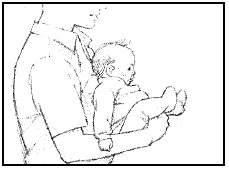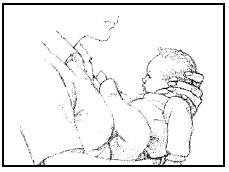
Caring for your crying baby
Preventing shaken baby syndrome
When a caregiver becomes frustrated, upset or angry at a crying baby, the caregiver may lose control and try shaking a baby to get them to calm down.
This video in English (above) and Spanish (below) explains what you can do to prevent shaken baby syndrome.
The U.S. Consumer Product Safety Commission advises that parents be cautious when using infant slings for babies younger than 4 months old.
A baby can stop breathing and die if their face is covered, if the baby is hunched with their chin touching their chest, if the baby is too low, or the baby’s face is pressed tight against the fabric of the sling.
When your baby cries
Crying is your baby's way of telling you they need some help. Your baby is trying to tell you they are hungry, tired, cold, hot, uncomfortable, bored or lonesome.
You may feel you are not being a good parent because you can't figure out what your baby wants right away. However, you are being a good parent by trying different things.
You can't spoil your baby by meeting their needs. You are helping your baby feel secure and loved. Babies who are carried and attended to quickly cry less than babies who only get attention when they cry.
As your baby gets older you will be better able to figure out what your baby needs. Your baby will also begin to cry less as they learn you will respond to their cries.
At times you may feel overwhelmed by your baby's crying. That can make you want to cry. It can also be frustrating that what works one time to settle your baby may not work the next. Try the things that have worked before, one at a time. Then try some of the ideas from the list below.
When your baby cries, try to figure out their cues. Is your baby tired, hungry, in pain, bored or overwhelmed? Try feeding, burping, changing your baby's diaper, adding clothes for warmth or taking them off if your baby is too warm.
If your baby still cries, try:
- calming techniques:
- changing positions
- swaddling (securely wrapping your baby in a receiving blanket)
- offering a breast
- offering a pacifier
- cuddling
- adding sound:
- talking
- singing
- playing a music box, radio or CD
- turning on a constant, droning sound like a fan, vacuum cleaner or hair dryer
- adding movement:
- rocking in your arms or across your lap
- rocking with you in a chair or in an infant swing (Newborns often prefer moving side-to-side in a rocking cradle rather than forward and back in a chair swing.)
- carrying your baby in a front carrier
- dancing to music
- bouncing gently with you on an exercise ball
- adding a change of scenery:
- walking around the room
- going outside
- taking a walk in a stroller
- taking a drive in the car
- taking your baby out of a room filled with people and into a quiet, private place to offer comfort
Sometimes babies have pent-up energy and cry to get rid of it. If nothing seems to be working and you sense yourself becoming overwhelmed or frustrated, it's OK to place your baby on their back in the crib. Your baby will be safe while you take a break.
Check on your baby every three to five minutes. If your baby continues to cry after 30 minutes of this, call your baby's health care provider.
While your baby is in the crib, you can:
- Try to relax yourself. Breathe deeply or do your relaxation breathing.
- Listen to music that is relaxing to you. It might help your baby, too.
- Ask a family member or friend to hold your baby and try to soothe them.
Remember that you are learning about each other. What you are learning now may help you next time.
If you find yourself getting angry or feeling overwhelmed, or if you don't feel calmer after taking a break, put your baby safely in their crib. Go to another room for five to 10 minutes. Ask for help from your partner, a relative or friend. Or, call a crisis nursery located near you, or call the Crisis Connection (crisis.org) at 612-379-6363612-379-6363.
Try the "colic curl" for a fussy baby.

Cradle your baby facing away from you with legs bent up in your hands.

Cradle your baby facing you with legs bent up against your chest.
You can also try the football hold. Lay your baby on your forearm with their stomach against your arm. Your baby should be lying on their stomach. Your baby’s head will be near your elbow and their legs will straddle your palm. Let your baby’s cheek rest on your forearm.
Shaken baby syndrome
Somali: Ciladda ilmaha la ruxay
When a caregiver becomes frustrated, upset or angry at a crying baby, the caregiver may lose control and try shaking a baby to get them to calm down.
Shaken baby syndrome is a type of brain injury caused by violently shaking a baby. Shaking causes a baby's brain to bounce back and forth in the skull.
Warning
Don't ever shake your baby to try to quiet crying. Call 911 if you think a caregiver is abusing your baby.
Shaking a baby — even for as little as five seconds — can cause:
- brain damage or swelling
- bleeding in the brain
- bleeding in the eyes or blindness
- spinal cord and neck damage
- broken ribs and bones
- disabilities such as cerebral palsy
- death
Symptoms of shaken baby syndrome depend on how hard the baby was shaken and for how long. Symptoms include:
- extreme irritability
- lethargy
- poor feeding
- breathing problems
- convulsions
- vomiting
- pale or bluish skin
Important: You can't cause shaken baby syndrome by gently bouncing your baby, playfully tossing them in the air, jogging with them, or putting them in a bouncer, swing or other motion type of baby equipment.